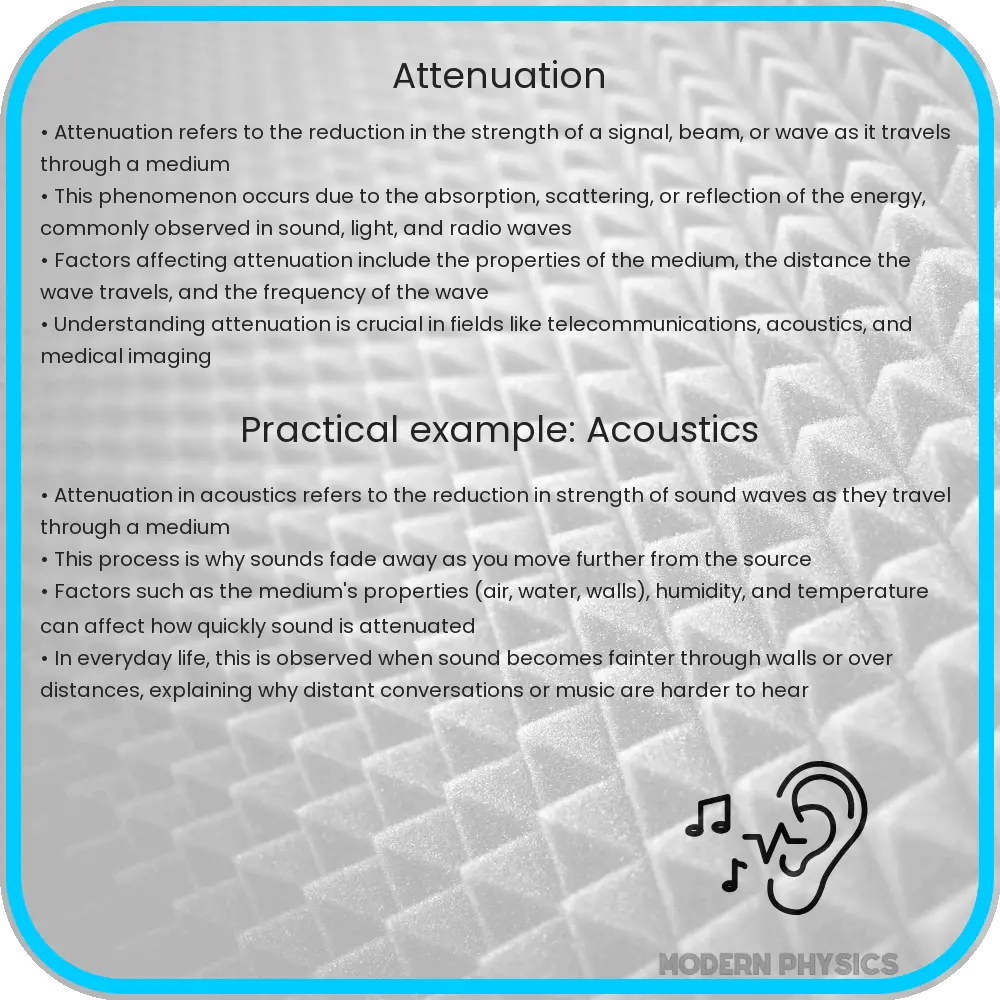Attenuation in acoustics refers to the reduction in sound intensity as it travels through a medium, influenced by absorption, scattering, and other factors.

Understanding Attenuation in Acoustics
Attenuation in acoustics refers to the reduction in the intensity of sound as it travels through a medium. This phenomenon is crucial for controlling noise levels in various environments, ensuring clear communication in audio systems, and even in architectural design to enhance room acoustics. In this article, we explore the basics of sound attenuation, its causes, and its implications for everyday applications.
The Basics of Sound Waves
Sound travels in waves, which are essentially vibrations that propagate through mediums such as air, water, or solids. The key characteristics of these waves include frequency, wavelength, and amplitude, all of which determine the nature of the sound we perceive. Frequency corresponds to the pitch, wavelength to the distance over which the wave’s shape repeats, and amplitude relates to the loudness of the sound.
What Causes Attenuation?
Several factors contribute to the attenuation of sound waves, including:
- Absorption: As sound waves travel through a medium, some of their energy is absorbed by the medium’s molecules, converting sound energy into heat. Materials like foam and fiberglass are excellent examples of absorptive materials used in soundproofing.
- Scattering: Interaction with small objects in its path can cause the redirection of sound waves from their original direction. This is commonly observed with rough surfaces or particulate matter suspended in air.
- Reflection: When sound waves encounter a surface, they are reflected back. This can lead to constructive or destructive interference, where waves add up to increase sound or cancel out to reduce it, respectively.
- Diffraction: Sound waves can bend around obstacles and spread out. This bending process weakens the sound as it occupies a larger area.
- Distance: Simply put, the further the sound has to travel, the more energy it loses. This natural spread of energy over an increasing area is called geometric spreading.
Mathematical Representation of Attenuation
The attenuation of sound can be quantified mathematically using the decibel (dB) scale. The sound intensity level can be expressed as:
L2 = L1 – 20 * log10 (d2 / d1)
Where L1 and L2 are the sound levels at distances d1 and d2 from the source, respectively. This equation highlights how sound levels decrease logarithmically with distance.
Understanding the attenuation of sound is vital not only for improving audio quality in various devices but also in designing quieter and more comfortable living and working environments. Beyond its practical applications, grasping the concept of sound attenuation enriches our comprehension of how sound interacts with our world, shaping everything from the music we enjoy to the buildings we inhabit.
In the next section, we will delve deeper into the practical applications of sound attenuation, examining case studies and exploring how different materials and designs can enhance or mitigate sound attenuation effectively.
Practical Applications of Sound Attenuation
Sound attenuation plays a pivotal role in various fields, ranging from engineering to environmental science. Here are some key applications:
- Building Acoustics: In architectural engineering, understanding and implementing sound attenuation strategies is critical. The use of absorptive materials within walls, floors, and ceilings can dramatically reduce noise levels, making spaces like classrooms, hospitals, and residential buildings quieter.
- Noise Control in Transportation: Effective sound attenuation measures are crucial in automotive, aerospace, and railway industries to enhance passenger comfort and comply with noise regulations. Techniques include the use of barrier walls, acoustic liners, and anti-vibration mounts.
- Audio Engineering: In the recording and broadcasting industries, controlling room acoustics is essential to eliminate unwanted echoes and feedback, ensuring the clarity and quality of sound.
- Environmental Protection: Sound attenuation is vital for protecting ecosystems from the disruptive effects of noise pollution, which can affect animal behaviors and health. Sound barriers and strict zoning are common practices to mitigate these effects.
Case Studies Highlighting Effective Sound Attenuation
To further illustrate the impact of sound attenuation, let’s examine a couple of case studies:
- Concert Hall Design: The renowned Symphony Hall in Boston is designed with meticulously calculated dimensions and materials that optimize sound distribution and minimize unwanted echoes. The strategic placement of absorptive panels and the use of heavy curtains adjust the acoustics according to the nature of the event, showcasing the application of sound attenuation in enhancing audio performance.
- Highway Noise Barriers: The implementation of sound barriers along highways in urban areas demonstrates how sound attenuation can be applied on a large scale. These barriers use materials like concrete and earth mounds to effectively reduce noise pollution for nearby residential areas.
These examples underscore the practical benefits and importance of effective sound attenuation across different environments and applications.
Conclusion
In conclusion, understanding the principles of sound attenuation is not only fundamental to acoustics but also essential in a wide range of practical applications. From improving the learning environment in schools to enhancing passenger comfort in vehicles and protecting wildlife from noise pollution, the effective management of sound through attenuation techniques plays a crucial role. As we have explored, the causes of attenuation, along with its mathematical quantification and practical implementations, provide significant insights and benefits across various industries. This makes the study of sound attenuation an exciting and valuable area not just for physicists and engineers, but for anyone interested in creating a more quiet and enjoyable environment.
By contemplating these principles and case studies, we gain a better appreciation of how engineered solutions can control and optimize sound in our surroundings, ultimately leading to innovations that enhance our daily lives and the environment.
